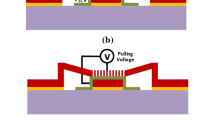Abstract
In this paper, a new switching beam design method is proposed. By using a beam design method to design a beam, an ultra-wideband radio-frequency micro electromechanical system (RF MEMS) switch with a frequency band of 1–110 GHz is designed. With this design method, in addition to using the equivalent capacitance between the switch beam and the signal line, you can also make full use of the fringe field effect between them. Therefore, it can greatly increase the capacitance ratio between the two states of the switch up and down. Finally, it achieves the purpose of extending the working bandwidth of the switch. In the up state, the return loss is less than 20 dB and the bandwidth is greater than 100 GHz. The insertion loss is less than 0.2 dB. The bandwidth is greater than 100 GHz. In the down state, the isolation is less than 10 dB and the bandwidth is greater than 90 GHz.










Similar content being viewed by others
References
Agarwal S (2017) Modeling and analysis of capacitance in consideration of the deformation in RF MEMS shunt switch. Superlattices Microstruct 101:567–574
Bian W (2019) Comparison of MEMS switches and PIN diodes for switched dual tuned RF coils. J Micromech Microeng 29:287–296
Chen Z (2017) Effect of surface asperities on the capacitances of capacitive RF MEMS switches. J Micromech Microeng 27:257–268
Deng Z (2016) Ka-band radiation pattern reconfigurable antenna based on microstrip MEMS switches. Progr Electromagn Res Lett 59:93–99
Heredia J (2019) A 125–143GHz frequency-reconfigurable BiCMOS compact LNA using a single RF-MEMS switch. IEEE Microwave Wirel Compon Lett 29:339–341
Jo E (2019) Integration of a carbon nanotube network on a microelectromechanical switch for ultralong contact lifetime. ACS Appl Mater Interfaces 11:18617–18625
Kolis P (2017) Quantification of uncertainty in creep failure of RF-MEMS switches. J Microelectromech Syst 26:283–294
Krishnan U (2019) A synoptic review of MoS2: synthesis to applications. Superlattices Microstruct 128:274–297
Maunder A (2018) Comparison of MEMS switches and PIN diodes for switched dual tuned RF coils. Magn Reson Med 80:1746–1753
Park SJ (2010) High–Q RF MEMS 4–6GHz tunable evanescent-mode cavity filter. IEEE Trans Microw Theory Tech 58:381–389
Shah U (2017) A 500–750 GHz RF MEMS waveguide switch. IEEE Trans Trans Terahertz Sci Technol 7:326–334
Wei H (2017) High on/off capacitance ratio RF MEMS capacitive switches. J Micromech Microeng 27:372–383
Xiao H (2018) Design and characterization of millimeter-wave micromachined polymer-based cavity filter with resonant cylinders. Sens Actuators A 284:242–250
Xu Y (2017) A novel RF MEMS switch on frequency reconfigurable antenna application. Microsyst Technol 24:3833–3841
Xu H (2018) Wide solid angle beam-switching conical conformal array antenna with high gain for 5G applications. IEEE Antennas Wirel Propag Lett 17:2304–2308
Zhang Y (2018) A high-linearity SP12T RF MEMS switch using parallel dual-cantilevers for 5G and beyond applications. IEEE Electron Device Lett 39:1608–1611
Acknowledgements
The author sincerely thanks to the Key Laboratory of Instrumentation Science & Dynamic Measurement (North University of China), Ministry of Education, and the computer and other equipment provided by the School of Instrument and Electronics (North University of China). Funded by the National Natural Science Foundation of China (No. U1637212); National Defense Pre-research Foundation of China (61404130402); Fund for Shanxi “1331 Project” Key Subject Construction; Fund for Key Laboratory (61428050104). Supported by Scientific and Technological Innovation Programs of Higher Education Institutions in Shanxi.
Author information
Authors and Affiliations
Corresponding author
Additional information
Publisher's Note
Springer Nature remains neutral with regard to jurisdictional claims in published maps and institutional affiliations.
Rights and permissions
About this article
Cite this article
Qin, R., Zhang, B., Lei, C. et al. A novel switch beam design method with extending switching radio-frequency bandwidth. Microsyst Technol 27, 315–324 (2021). https://doi.org/10.1007/s00542-020-04956-w
Received:
Accepted:
Published:
Issue Date:
DOI: https://doi.org/10.1007/s00542-020-04956-w




